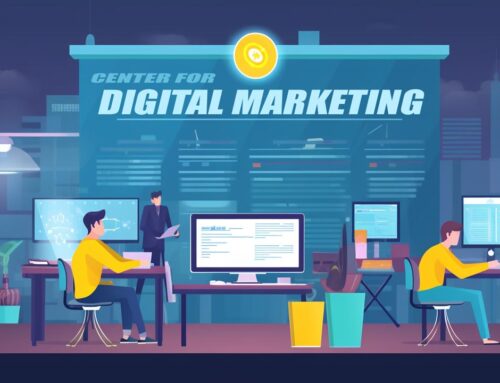Businesses of all sizes and industries must harness the power of digital marketing to remain competitive, build brand awareness, and drive growth. Whether you’re a small business owner, an aspiring digital marketer, or a professional looking to expand your skillset, this comprehensive guide will provide you with the essential knowledge, tools, and strategies to help you successfully navigate the world of digital marketing. From understanding the fundamentals and defining your goals to selecting the right channels and optimizing your campaigns, this guide will walk you through the entire process step-by-step, ensuring you’re well-equipped to take your digital marketing efforts to new heights.
This guide will walk you through the steps to start and succeed in digital marketing, even if you’re a beginner.
Table of Contents
- Understanding Digital Marketing
- Define Your Goals
- Identify Your Target Audience
- Choose Your Digital Marketing Channels
- Create a Content Strategy
- Optimize for SEO
- Leverage Analytics and Reporting
- Continuous Improvement and Adaptation
1. Understanding Digital Marketing
Before you dive into digital marketing, it’s essential to understand the core concepts and various channels.
What is Digital Marketing?
Digital marketing is the promotion of products, services, or brands through digital channels, such as:
- Search engines
- Social media
- Email marketing
- Content marketing
- Mobile marketing
- Affiliate marketing
2. Define Your Goals
Start by outlining your digital marketing goals. These may include:
- Increasing brand awareness
- Generating leads
- Boosting sales
- Engaging with customers
- Growing social media following
Ensure that your goals are SMART (Specific, Measurable, Achievable, Relevant, and Time-bound).
3. Identify Your Target Audience
Understanding your target audience is crucial for creating effective marketing campaigns. Consider:
- Demographics (age, gender, income)
- Geographic location
- Interests and hobbies
- Pain points and challenges
Create buyer personas to help visualize your ideal customers and tailor your marketing efforts accordingly.
4. Choose Your Digital Marketing Channels
Select the most suitable channels for your business based on your goals, target audience, and resources. Common channels include:
Search Engine Optimization (SEO)
Improve your website’s visibility on search engines by optimizing its content, structure, and design.
Social Media Marketing
Promote your business on platforms like Facebook, Instagram, LinkedIn, Twitter, and Pinterest.
Content Marketing
Create and distribute valuable content to attract and engage your target audience, such as blog posts, videos, and infographics.
Email Marketing
Use targeted and personalized email campaigns to nurture leads and maintain customer relationships.
Pay-Per-Click (PPC) Advertising
Run paid ads on platforms like Google Ads and Facebook Ads to drive traffic and generate leads.
5. Create a Content Strategy
Develop a content strategy to guide your marketing efforts. Consider the following:
- Types of content (blog posts, videos, podcasts, etc.)
- Content topics and themes
- Content distribution channels
- Content creation schedule
- Call-to-action (CTA) for each content piece
6. Optimize for SEO
Ensure your content is easily discoverable by search engines. Key SEO techniques include:
- Keyword research
- On-page optimization
- Meta tags (title, description, headers)
- URL structure
- Internal and external linking
- Off-page optimization (backlinks, social signals)
- Technical SEO (site speed, mobile-friendliness, XML sitemap)
6. Optimize for SEO (continued)
- Technical SEO (site speed, mobile-friendliness, XML sitemaps)
Local SEO
If you have a local business, focus on local SEO strategies, such as:
- Google My Business listing optimization
- Local citations and directories
- Reviews and ratings
- Localized content
7. Leverage Analytics and Reporting
Measure the performance of your digital marketing efforts and make data-driven decisions. Use tools like:
- Google Analytics
- Google Search Console
- Social media analytics
- Email marketing analytics
Track key performance indicators (KPIs) relevant to your goals, such as:
- Website traffic
- Conversion rate
- Bounce rate
- Click-through rate (CTR)
- Cost per acquisition (CPA)
8. Continuous Improvement and Adaptation
Digital marketing is a dynamic field. Stay up-to-date with industry trends and best practices. Regularly review and adjust your strategies based on your analytics and insights. Engage in continuous learning through:
- Online courses and certifications
- Blogs and industry publications
- Webinars and podcasts
- Networking events and conferences
Final Thoughts
Remember, patience and persistence are key, as it may take time to see the desired results. Keep learning, experimenting, and adapting to stay ahead in the ever-evolving digital landscape.
Embarking on your digital marketing journey may seem daunting, but by following the steps outlined in this guide, you can build a strong foundation for long-term success. Begin by understanding the fundamentals of digital marketing and defining your goals, while keeping your target audience at the heart of your efforts. Carefully select the most appropriate digital marketing channels for your business, and craft a strategic content plan that aligns with your objectives. Optimize your campaigns for search engines, and never underestimate the power of data analytics in driving informed decisions.
As you continue to refine your digital marketing strategies, remember that the landscape is constantly evolving. Stay informed about the latest trends, tools, and best practices, and don’t be afraid to experiment with new tactics and channels. Lastly, embrace a growth mindset and be prepared to adapt and pivot as needed. By doing so, you’ll be well on your way to mastering digital marketing and unlocking the full potential of your business in the digital age.








